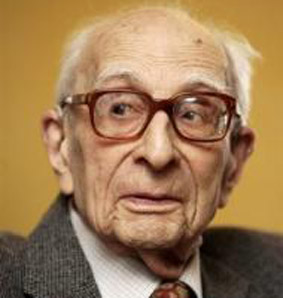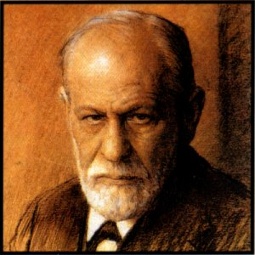The Id of the Yid
 Our Apoplectic Invaders Considered.
Our Apoplectic Invaders Considered.
The Ordeal of Civility: Freud, Marx, Levi-Strauss, and the Jewish Struggle with Modernity by John Murray Cuddihy (pictured); Basic Books, 1974.
Reviewed by Hugh Lincoln
DECADES BEFORE Kevin MacDonald embarked on his Jewish trilogy, a little-known sociology professor at New York City’s Hunter College came to suspect that the Jewish intellectual movements of the 19th and 20th centuries weren’t quite the marvels of universal application imagined by academia and later by wider society. Rather, they were elaborate coping mechanisms designed to de-racialize the social conflicts between Gentile Europe and newly emancipated Jewry. It was MacDonald who expanded “coping” to “destroying” in the context of Jewish-Gentile relations, but John Murray Cuddihy is to be credited for one of history’s more thoroughgoing, if obscure, exposures of Jewish deception.
Cuddihy, who retired in 1998, is presumably not a racialist. He speaks more of “culture” than ethnicity or even race, and might even consider himself sympathetic to Jews. The book, The Ordeal of Civility: Freud, Marx, Levi-Strauss, and the Jewish Struggle with Modernity, was published in 1974. It is spoken of in reverent tones by the writer who calls himself Yggdrasil and other learned White nationalists. But some racially conscious Whites confess that the book does not speak to them. Inaccessibly dense and academic, they say — a sentiment with which I came to sympathize as I read the book. The Ordeal of Civility is not light reading. It is also difficult to find. But within the yellowed pages of my used copy, purchased over the Internet, I found a surprisingly damning analysis of Jewish motivations.
Cuddihy’s thesis goes roughly as follows: Upon the granting of emancipation to the Jews of Europe*, their less-refined ways, developed over centuries within their tightly bound tribal lives, bumped rudely into the carefully cultivated behavioral codes of the larger Gentile communities of Europe. The closer Jews tried to get, the more intense the conflict became. The Jewish intellectual elite cringed when the ostjuden, or unassimilated Jews, made a spectacle of themselves in European civil society. Cuddihy cites the example of the Victorian-era social reformer Beatrice Potter, who found herself disgusted by the Jews of London’s East End: “… the immigrant Jew, though possessed of many first-class virtues, is deficient in that highest and latest development of human sentiment — social morality… He totally ignores all social obligations other than keeping the law of the land, the maintenance of his own family, and the charitable relief of coreligionists.”
[*Prussian Jewry’s Emancipation Edict, for instance, was granted on March 11, 1812.]

Jewish intellectuals were well aware that views such as Potter’s prevailed. Their minds raced to concoct explanations for the conflict that steered clear of the most obvious one: race. Karl Marx described it as a class conflict rooted in economic maldistribution. Sigmund Freud described it as a medical malady rooted in suppressed natural urges. The “structuralism” of French anthropologist Claude Levi-Strauss, propounded in the 1960s and 1970s, asserted that no one culture was better than any another, leaving open the possibility that, if anything, Western culture was loaded with hypocrisy and trivial etiquette while non-Western cultures were more admirably “natural.”
The propounding of such ideas, Cuddihy says, sprang from Jewish “status humiliations of modernity,” the “wound in the heart” suffered by their encounter with a larger and more refined Gentile society, an encounter that left them feeling inferior. “Structuralism, like Marxism, is an ideology of subcultural despair, an uneasy mélange of cognitive relativism and ethical absolutism,” Cuddihy says. By Gentile “modernity,” Cuddihy meant the separation of the private from the public that evolved as Gentile Europe moved from animal skin-wearing tribalism to civil societies with public institutions. The transition saw the development of new social rituals that would have been unnecessary in a close-knit society in which everyone was intimately acquainted with everyone else. Jews, not having undergone such changes, developed no such rituals.
As I imagine it, the Jewish intelligentsia were prompted into a “fight or flight” mental reaction. In application, it combined both fighting and ‘flighting.’ The fighting was the criticism of Gentiles for living their lives in ways that were, to us, completely natural. The ‘flighting’ was the deceptive aspect of that fighting: Jews did not confront Gentiles qua Gentiles. Rather, they sought alternate explanations that served to mollify their embarrassment at the behavior of their own people. From the introduction: “As we shall see, the ideology of the Jewish intellectual is frequently a projection onto the general, Gentile culture of a forbidden ethnic self-criticism. Shame for ‘one’s own kind’ is universalized into anger at the ancestral enemy… ‘Neither Jew nor Gentile is to be blamed for the tsursis (trouble) of the Diaspora: it is but a symptom of the capitalist exploitation (Marx) or a medical symptom of anxiety (Freud),'” Cuddihy says, echoing the hoped-for reception of the Jewish ideas. The analysis rings true. I am convinced (no, not by reference to Freud) that a primary motivator for the human thought process is the desire to “get comfortable” with any given situation, from the immediate and personal to larger social or political realities. Getting comfortable need not be mere self-adjustment — it can also mean the alteration of the environment itself, like a prehistoric human smashing down grasses to make a bed. As I understand Cuddihy, Jews were doing both: creating ideologies that comforted them with reassurances of equality, and, if accepted by Gentiles, made for pliant enemies.
Cuddihy is short on vivid examples of the culture clash that so motivated (and was misunderstood by) the Jewish intelligentsia, but several emerge in his treatment of Freud. Consider Freud’s reaction to privacy. Within the insulated Jewish community of the shtetl, or Jewish ghetto, “privacy” was seen as abnormal — anyone desiring personal space must be hiding something and is suspect. It did not occur to Freud that Gentile culture, having developed into a larger society, may well have had good reasons for respecting the personal space of others. In the nineteenth century, Eastern European Jewry “mistakes privacy for secrecy.” The ways in which European Gentiles institutionalized the need to be private in public, or the need for decorum, is “lost on the Jewish intelligentsia of the nineteenth century. To them, it appears as so much hypocrisy.” Cuddihy quotes Philip Rieff’s Freud: The Mind of the Moralist: “What is for Freud ‘repression’ psychologically understood, is ‘secrecy’ morally understood. Secrecy is the category moral illness, for it provides a hiding place for false motives.”

In other words, Freud described as “sick” Gentile behavior that was, to us, healthy and necessary. But it was not out of mere misunderstanding that Freud came to his conclusions. Animosity toward Gentiles played no small part. Freud, laid out on Cuddihy’s couch, recalls a childhood episode that burned into him a desire to “get even” with the exclusionary enemy. Freud’s father, Jacob Freud, was walking down the sidewalk in Moravia and bumped into a Gentile. “Jew! Get off the pavement!” snarled the Gentile. The elder Freud’s hat was knocked into the gutter. His reaction is not to leap to the Gentile’s throat, but to calmly retrieve his hat from the gutter and continue on his way. Freud, as it happens, didn’t witness any of this. The recounting by his father was enough. Is it possible that this episode created Freud’s fantasy that by developing “psychoanalysis,” he would become the Semitic conqueror of Gentile Europe? Like Hannibal astride his elephant, he would storm Rome and exact vengeance on the hated goyim.
Freud on Hannibal:
When I finally came to realize the consequences of belonging to an alien race, and was forced by the anti-Semitic feeling among my classmates to take a definite stand, the figure of the Semitic commander assumed still greater proportions in my imagination. Hannibal and Rome symbolized, in my youthful eyes, the struggle between the tenacity of the Jews and the organization of the Catholic Church. The significance for our emotional life which the anti-Semitic movement has since assumed helped to fix the thoughts and impressions of those earlier days. Thus the desire to go to Rome has in my dream-life become the mask and symbol for a number of warmly cherished wishes, for whose realization one had to work with the tenacity and single-mindedness of the Punic general, though their fulfillment at times seemed as remote as Hannibal’s life-long wish to enter Rome.
And now, for the first time, I happened upon the youthful experience which even today still expresses its power in all these emotions and dreams. I might have been ten or twelve years old when my father began to take me with him on his walks, and in his conversation to reveal his views on the things of this world. Thus it was that he once told me the following incident, in order to show me that I had been born into happier times than he: “When I was a young man, I was walking one Saturday along the street in the village where you were born; I was well-dressed, with a new fur cap on my head. Up comes a Christian, who knocks my cap into the mud, and shouts, ‘Jew, get off the pavement!'” — “And what did you do?” — “I went into the street and picked up the cap,” he calmly replied. That did not seem heroic on the part of the big, strong man who was leading me, a little fellow, by the hand. I contrasted this situation, which did not please me, with another, more in harmony with my sentiments — the scene in which Hannibal’s father, Hamilcar Barcas, made his son swear before the household altar to take vengeance on the Romans. Ever since then Hannibal has had a place in my phantasies.
It is no accident that “id” mimics “Yid.” “In psychoanalysis, the ‘id’ is the functional equivalent of the ‘Yid’ in social intercourse,” Cuddihy says. “The id, in other words, was a moral equalizer legitimating ‘scientifically’ social equality between Jew and Gentile in late nineteenth-century Europe.” Cuddihy quotes a Howard Morley Sacher on “the unconscious desire of Jews, as social pariahs, to unmask the respectability of the European society which closed them out,” adding that in Freud’s case, it was the conscious desire of a conscious pariah. “There was no more effective way of doing this,” Sacher is quoted as saying, “than by dredging up from the human psyche the sordid and infantile sexual aberrations that were frequently the sources of human behavior. Even Jews who were not psychiatrists must have taken pleasure in the fact of social equalization performed by Freud’s ‘new thinking.’ The B’nai B’rith Lodge of Vienna, for example, delighted in listening to Freud air his theories.”
Cuddihy’s presentation ironically draws upon the same motivation exposition techniques employed by Freud. When Jews sneer that Gentiles are embarrassed by sex and need to be “unmasked,” Cuddihy points out that what they’re trying to do is strip all humanity to base commonalities in an effort to make their crude, uncivilized selves feel more acceptable, all the while rudely ignoring the evolved and genuine social need for Gentile conventions. The Gentile is left shamed and confused, convinced that he must “let it all hang out” if he is to achieve mental health. Freud is revealed as a clever Jew pleased with himself for having pulled the Gentile’s pants down to point out to the assembled crowd that, like other mammals, this one’s got genitalia. Cuddihy coolly returns the favor. Freud himself might have had some insight on this, as he was reported to have once wondered: Am I an original scientist or just a dirty Jew?
What Freud sought by subversion, Marx sought by revolution. Jewish-Gentile conflict for Marx was seen not as a racial battle but as class struggle. In this respect, Marxism found a parallel with Zionism. “Jewish radicals analyzed anti-Semitism as incidental to the class struggle and expected it to disappear in the ruins of the capitalist system,” Cuddihy quotes a Ben Halpern as saying. Cuddihy continues: “Zionists planned to heal at one stroke the wound to national self-esteem by leaving Europe — and by leaving behind the invidious comparisons fatal to remaining there. Marxists planned to kill the ‘Jewish question’ by revolution, not emigration: at one stroke, all would be changed, changed utterly, as a species-humane community is born.” History, of course, would not bear out anything “humane” resulting from Marxism, socialism, or communism.
Toward the end of the book, Cuddihy offers a revealing account of the “Chicago Seven” trial, featuring a showdown between Jewish radical Abbie Hoffman and the assimilated Jewish judge, also named Hoffman. The exchanges (“You’re a disgrace to the Jews, runt!” Abbie Hoffman yells at the judge. “You should have served Hitler better!”) are seen by Cuddihy as revealing the very clashes Marx and Freud witnessed and sought to explain away.
Today, excluding college campuses, Marxism holds little sway. Freud’s ideas find a few purist adherents, though many therapists have distanced themselves from his theories. But observe the damage done, and how Jews have deftly avoided blame for the misery caused. To the untutored, they are tough to spot, darting quickly from movement to movement under a cover of proclaimed universalism. For once an intellectual or political movement loses utility for Jews, they abandon it. I believe that the Jewish tendency so well described by Cuddihy finds its fiercest manifestation today in “neo-conservatism,” a two-headed beast of race-denying social liberalism and pro-Israel warmongering. Jews in government and media line up to feed this beast, which serves them nicely at the dawn of the new century. It looks “conservative” and thus beats the charge that Jews are liberals, yet pushes simultaneously for the American multiculturalism that makes them comfortable in the U.S., and the Jewish exclusionism that makes them comfortable in Israel. If there is a deviation from Cuddihy’s thesis, it is this: Neo-conservatism and other Jewish maneuvering is no “Jewish struggle” evocative of sympathy for a “Diaspora people.” It is child’s play for Jews. Jews no longer struggle with modernity, they define it. It is now White Americans who are strangers in a strange land. Life in deracinated America is the relevant struggle. It is our ordeal of incivility. Restoring racial sanity will require the emergence of a counterforce: our own intellectual elite, a group of racially conscious Whites disheartened enough by what they see happening to speak out, and inspired enough to lead the way out.
(The preceding review appeared in National Vanguard, No. 121, edited by Kevin Alfred Strom. The quotation from Freud does not appear in the original.)
Hugh Lincoln is an attorney living in New York City.
Read the source article at the Racial Nationalist Library





